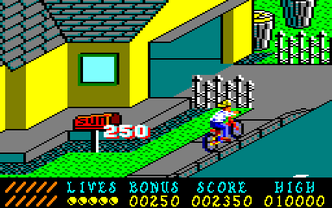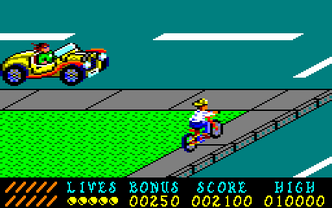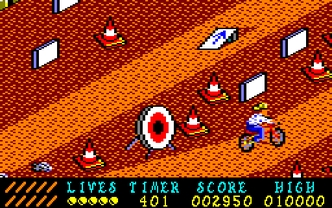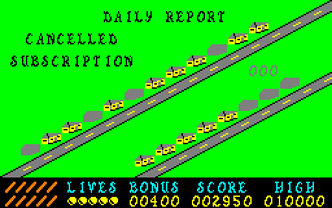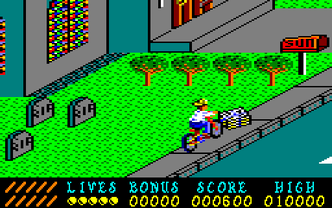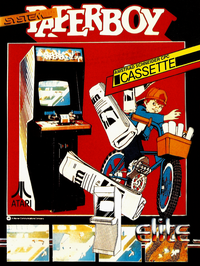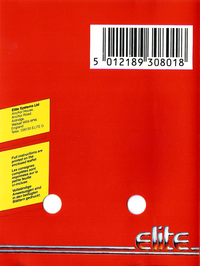Navigation:
Paperboy Amstrad CPC
This game entry is not "published" yet and will not appear in game browers by default! (Edit and set publish = 1)
Pick up your old Push Bike, put on your peaked cap and imagine yourself braving the streets of an American suburb. Only superb riding skills and a steady throwing arm can get yu through your seven day week of hilarious action. Avoid cars, workmen, drunkards and lawnmowers all out to obstruct you in your pursuit of excellence. Score points by delivering to all your usual customers, but you can get sneaky bonuses by breaking the windows of non-subscribers. It's a difficult task but your employer believes that practice makes perfect and generously provides a practice track where you can score valuable extra points. Get ready for the ride of your life. — Cassette cover
Paperboy is a 1984 arcade game by Atari Games. The players take the role of a paperboy who delivers newspapers along a suburban street on his bicycle. The game was ported to numerous video game consoles and personal computers. The Nintendo Entertainment System (NES) version represented the first NES game developed in the United States. Paperboy was innovative for its theme and novel controls.
Gameplay
The player controls a paperboy on a bicycle delivering newspapers along a suburban street which is displayed in a cabinet perspective view. The player attempts to deliver a week of daily newspapers to subscribing customers, attempts to vandalize non-subscribers' homes and must avoid hazards along the street. Subscribers are lost by missing a delivery or damaging a subscriber's house.
The game begins with a choice of difficulty levels: Easy Street, Middle Road and Hard Way. The object of the game is to perfectly deliver papers to subscribers for an entire week and avoid crashing (which counts as one of the player's lives) before the week ends. The game lasts for seven in-game days, Monday through Sunday. Controlling the paperboy with the handlebar controls, the player attempts to deliver newspapers to subscribers. Each day begins by showing an overview of the street indicating subscribers and non-subscribers. Subscribers and non-subscribers' homes are also easy to discern in the level itself,[1] with subscribers living in brightly colored houses, and non-subscribers living in dark houses.
Paperboy was ported to consoles and home computers, starting in 1986. In some of these versions, the player could assume the role of a papergirl instead of a paperboy. Paperboy was ported to the BBC Micro and Acorn Electron (by Andy Williams, 1986), Commodore 64 (by Chris Harvey and Neil A Bate, 1986), Commodore 16 (1986), Amstrad CPC (1986), ZX Spectrum (1986), Apple II (1986), TRS-80 Color Computer (1986), DOS (1988), Apple IIGS (1988), NES/Famicom (1988)(1991, Japan), Game Boy (1990), Game Boy Color (1999), Atari ST (1989), Amiga (1989), Atari Lynx (1990), Sega Master System (1990), Game Gear (1991), and Sega Mega Drive/Genesis (1991)(1992, Japan). The NES version is particularly notable for being the first NES game developed in the United States.
Unlike the arcade version, several of these versions inspired a sequel, Paperboy 2 for several home systems (Amiga, Amstrad CPC, Atari ST, DOS, Game Boy, Game Gear, Sega Genesis, NES, SNES, ZX Spectrum), and a 3D version for the Nintendo 64 called Paperboy 64.
Source:Wikipedia

